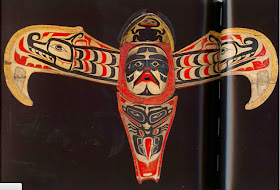http://culturalenvironments.blogspot.com/2012/05/mapping-family-romance.html
and
http://culturalenvironments.blogspot.com/2012/05/imaginary-maps.html
But how, rather than lecturing, to engage students in a critical conversation about the show and the broader topics of race and difference in imaginary map and speculative fiction?
One might start with engaging students in a conversation in front of Tolkien's map of the world of Arda and the long debated question of how deeply embedded British imperial racism is within the Rings book: one might note the depiction of the darker (or "Mongol-like") Orcs as epitomizing the demonic, and the Manichean struggle between Light and Dark through the series. Tolkien's maps of the Arda world, it has been noted, are roughly modeled on the actual world map (with the Americas and the Eurasia being linked through a vast kind of land-bridge across the equivalent of the North Atlantic.) His maps do seem to be racially coded: his white skinned heroic peoples are located in the geographical region of the map that seems to correspond to Europe, "Mordor" is literally "The Dark Land," and his darker skinned villainous "easterlings" and "southrons" come from regions that seem to correspond to Asia and Africa, respectively.
 |
| C.S.Lewis, Narnia map |
But then it would be interesting if members of the class argued about the question of the impact of these works. After all, some might argue, fiction allows for "interpolated readings", in which readers may profoundly identify with protagonists across literal lines of race, gender or class, and find deeply meaningful ways to vicariously co participate in journeys of heroic self fashioning.
At that point, it might be worth introducing the famous "I sit with Shakespeare" passage in W.E.B. DuBois in The Souls of Black Folk:
I sit with Shakespeare and he
winces not;
I move arm in arm with Balzac and
with Dumas,
where smiling men and welcoming
women glide in gilded halls.
From out the caves of evening
that swing between the
strong-limbed earth
and the tracery of the stars,
I summon Aristotle and Aurelius
and what soul I will,
and they come with no scorn or
condescension.
So, wed with truth, I dwell above
the veil,
above the dull red hideousness of Georgia;
and standing upon this high
Pisgah,
between Philistine and AmalekiIn a sense, DuBois in this passage constructs his own imaginary literary map, which he populates with European authors and their creations, transposed onto the topos of the Holy Land. Not insignificantly he situates himself upon the peak of Pisagh/Mt. Nebo, from which Moses gazed into the Promised Land, the land which he would never himself enter. (DuBois' words would be in a sense echoed six decades later in Dr. Martin Luther King Jr.'s "I've been to the Mountaintop" speech, delivered the night before death: "I might not get there with you...")
 |
| Earthsea (Ursula LeGuin) |
Or we might discuss the speculative fiction of Octavia Butler, in which the heroines are generally of African descent (no drawn maps, so far as I can recall) but who are enmeshed in nuanced and complex fields of interracial and interspecies desire.
To be sure, it is challenging to hold such conversations when students vary greatly in the speculative fiction with which they are familiar. So it might be easiest to concentrate on books and films, or multiplayer video games, which are most likely familiar to most students (discussing racial imagery and casting in the Harry Potter or Twilight books and films, for instance).
Finally, when students are invited to make their own maps of imaginary worlds, it might be worth discussing whether or not any of them feel called upon to signify the race or ethnicity of their protagonists. Are "post racial" fantasy maps possible or are race and power forever embedded in cartographic representations, even (especially?) at levels of the avowedly imaginary?




